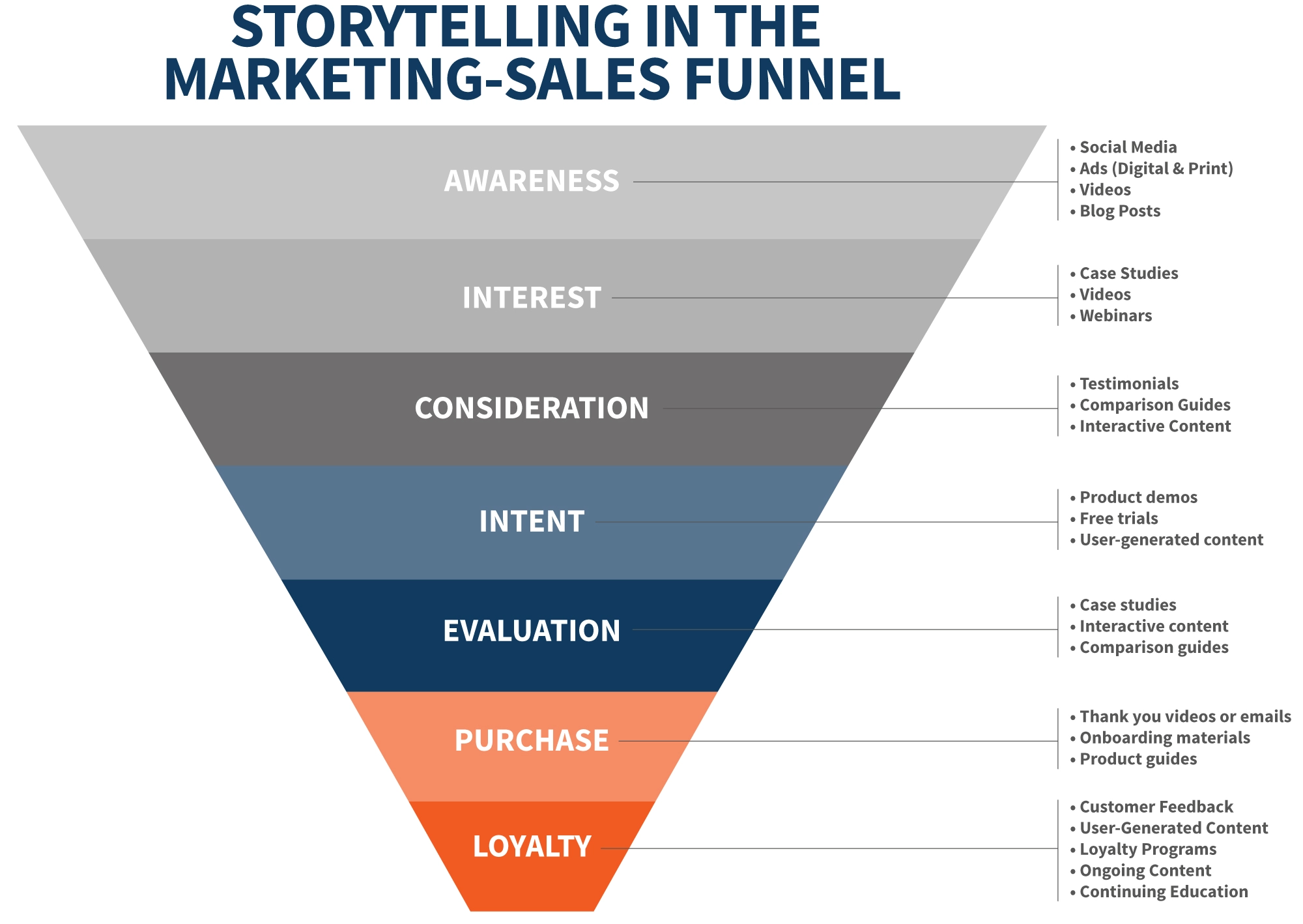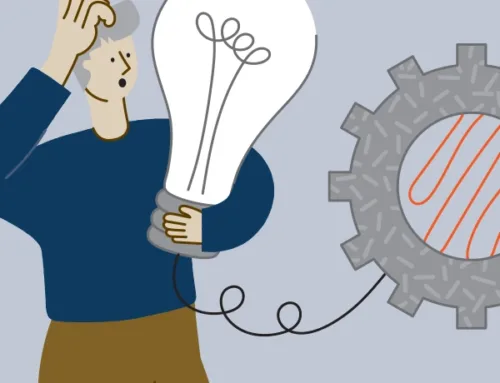In the final installment of our The Art of StorySelling series, we learn about how good storytelling can help your sales team succeed.
The Art of StorySelling
Marketers Are Modern Storytellers | Write Brand Stories that Sell | Add Stories to Your Marketing | White Paper
We all know that effective content marketing requires good storytelling, but did you know that storytelling principles can also be used in sales?
This technique, called storyselling, uses the psychology of storytelling to reinforce the connection between customer needs and product or service benefits. By using stories that sell, you, as a sales professional, will be able to better engage prospects, overcome objections and build brand loyalty.
Storytelling for Sales Professionals
The basic idea behind storyselling is that people are more likely to listen to stories than sales pitches or ads because they:
- Tap into the emotional and psychological aspects of human behavior
- Create empathy between customer needs and product or service benefits
- Allow brands to connect with their audience on a deeper level than traditional advertising methods
- Help make the brand or product more memorable
- Allow brands to differentiate themselves from their competitors
In sales, stories can be an effective technique to help engage prospects, close more deals, shorten your sales cycle, and build long-term customer relationships. Here are some actionable ways sales professionals can use storytelling in their sales process:
Use stories to connect emotionally with customers. Telling stories that resonate emotionally can help a sales professional establish a connection and build rapport with the customer. A well-crafted story can evoke emotions such as empathy, joy, or excitement, which can help the customer feel more positively towards the product or service being sold.
Use stories to illustrate benefits. Rather than listing features or specifications, a sales professional can use a story to show how the product or service has solved a problem for someone else or made their life better. This can help the customer understand the value of the product or service and see how it could benefit them.
Use stories to overcome objections or concerns. By telling a story about how someone overcame a similar objection or concern, a sales professional can demonstrate how the product or service can still be valuable despite the objection.
Use stories to make a pitch more memorable. Customers are more likely to remember a story than a list of features or benefits. This can help a sales professional stand out from the competition and increase the chances of the customer taking action.
Use customer success stories. By telling the story of how a product or service helped another customer achieve their goals, a sales professional can demonstrate the value and effectiveness of the product or service.
Sales and Marketing Collaboration
The relationship between sales and marketing often gets reduced to “makers vs takers”, but the reality is they are interdependent functions whose close collaboration is critical for the success of an organization.
One way in which this symbiotic relationship can lead to amazing outcomes is with storyselling. Sales and marketing teams can work together to collect feedback, curate stories, create assets, and distribute materials that help prospects build the kind of emotional connection that closes deals.
Some storyselling-based marketing materials that help support sales functions include:
- Case studies: Case studies are an excellent way to showcase customer success stories and demonstrate the value of a product or service.
- Testimonials: Testimonials from satisfied customers can be used to reinforce the benefits of a product or service and build trust with potential customers.
- Product demos: Product demos can be used to tell a story about how a product or service works and how it can solve a customer’s problem.
- Videos: Videos are a great way to tell stories visually and can be used to showcase customer success stories, product demos, or other marketing messages.
- Infographics: Infographics can be used to tell a story visually and illustrate the benefits of a product or service in a clear and engaging way.
StorySelling in the Marketing-Sales Funnel
In today’s competitive market, it’s not enough for marketing to just create awareness about your product or service. It’s about crafting a compelling story that captures your audience’s attention and creates an emotional connection that leads to long-term loyalty.
Here’s how storyselling can help guide your customers through each step of the marketing-sales funnel and create a seamless and engaging customer experience.

Awareness
- Social media posts and ads that use storytelling to introduce your brand and create interest
- Videos that tell a story about a problem or pain point that your target audience may be experiencing
- Blog posts that tell stories related to your industry or niche
Interest
- Case studies that showcase how your product or service has helped solve a problem for other customers
- Videos that provide more in-depth information about your product or service and how it works
- Webinars that tell a story about a particular topic related to your industry or niche
Consideration
- Testimonials or reviews from satisfied customers that tell a story about their experience with your product or service
- Comparison guides that tell a story about how your product or service compares to your competitors
- Interactive content such as quizzes or assessments that use storytelling to educate your target audience about their pain points and how your product or service can help
Intent
- Product demos that tell a story about how your product or service works and how it can solve a customer’s problem
- Free trials that allow customers to experience your product or service for themselves and tell a story about its benefits
- User-generated content that tells a story about how other customers are using your product or service
Evaluation
- Case studies that tell a story about how your product or service has helped other businesses in a similar situation
- Interactive content such as calculators that use storytelling to illustrate the financial benefits of your product or service
- Comparison guides that tell a story about how your product or service is superior to your competitors
Purchase
- Thank you videos or emails that tell a story about your business, contact or product experience
- Onboarding materials use storytelling to educate customers on how to use the product effectively
- Product guides that incorporate storytelling to help customers see the value of the product in real-life situations
Loyalty
- Customer feedback to curate stories about how the product or service has helped them achieve their goals or overcome challenges
- User-generated content, such as customer reviews or social media posts, that showcase the product or service in action
- Loyalty programs that offer rewards and incentives for continued use of the product or service
- Exclusive content that provides ongoing education or value to the customer, such as newsletters, blog posts, or webinars, to deepen their relationship with the brand.
In Closing
Storyselling works, but when applied to the sales process, it works even better. But if you want to successfully employ this technique, you have to make your audience feel something.
Telling stories that resonate emotionally and illustrate the benefits of your product or service, can help you reinforce the connection between your brand and customers’ needs. For sales professionals, that means engaging your prospects, closing more deals, and forging long-term customer relationships.
By working together, sales and marketing teams can create storytelling-based marketing materials that support the sales process and help prospects build the kind of emotional connection that closes deals.
To get started incorporating storyselling into your sales process:
- Identify the stories that your customers are already telling.
- Talk to your sales and customer service teams to understand what your customers care about and what problems they are trying to solve.
- Work with your marketing team to create materials that tell these stories in a compelling and memorable way.
Need help with case studies, testimonials and other storytelling-based marketing materials? Contact us, or check out the other parts of our The Art of StorySelling series: How Marketers are Modern Storytellers, How to Write Brand Stories that Sell, and How to Add Stories to Your Marketing Strategy.
FREE DOWNLOAD: A Step-by-Step Guide to Effective StorySelling
Now that you understand the basics, download Once Upon a Time: How StorySelling Can Supercharge Your Sales and Marketing. It’s the ultimate guide to incorporating StorySelling into your marketing strategy and boosting results!
This article was originally posted in 2010 under the titles StorySelling as an Effective Sales Closing Technique (Part 1) and StorySelling as an Effective Sales Closing Technique (Part 2). Content and title have been updated to reflect current content marketing trends.






